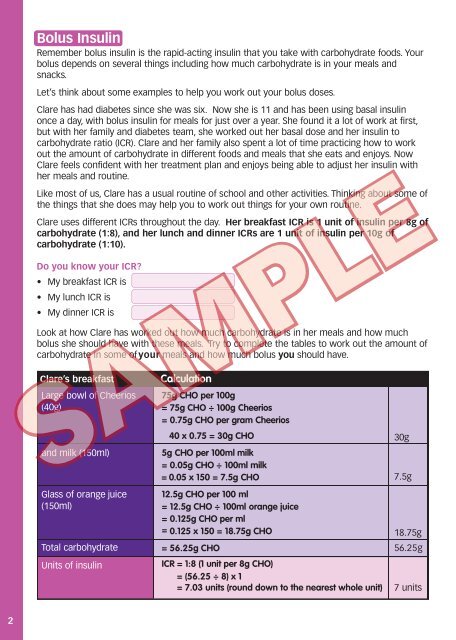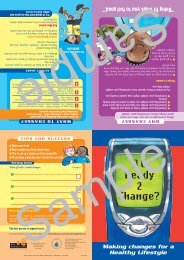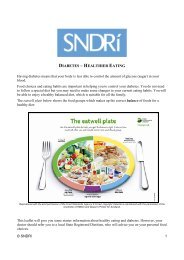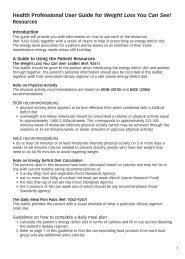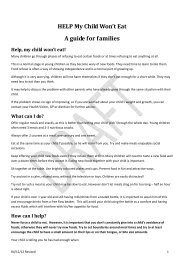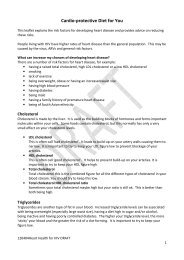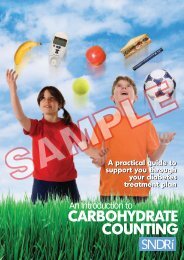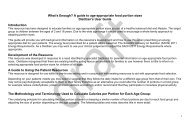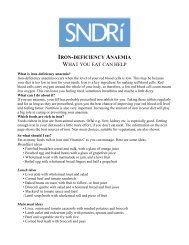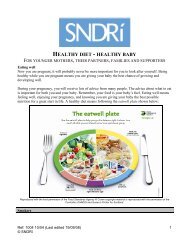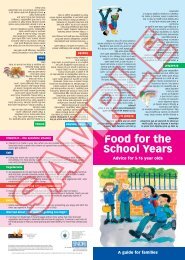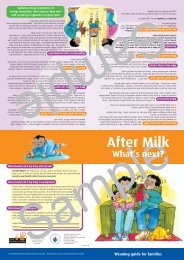Bolus Insulin - NDR-UK
Bolus Insulin - NDR-UK
Bolus Insulin - NDR-UK
Create successful ePaper yourself
Turn your PDF publications into a flip-book with our unique Google optimized e-Paper software.
<strong>Bolus</strong> <strong>Insulin</strong><br />
Remember bolus insulin is the rapid-acting insulin that you take with carbohydrate foods. Yo u r<br />
bolus depends on several things including how much carbohydrate is in your meals and<br />
s n a c k s.<br />
L e t ’s think about some examples to help you work out your bolus doses.<br />
Clare has had diabetes since she was six. Now she is 11 and has been using basal insulin<br />
once a day, with bolus insulin for meals for just over a year. She found it a lot of work at first,<br />
but with her family and diabetes team, she worked out her basal dose and her insulin to<br />
c a r b o h y d rate ratio (ICR). Clare and her family also spent a lot of time practicing how to work<br />
out the amount of carbohydrate in different foods and meals that she eats and enjoys. N o w<br />
Clare feels confident with her treatment plan and enjoys being able to adjust her insulin with<br />
her meals and routine.<br />
Like most of us, Clare has a usual routine of school and other activities. Thinking about some of<br />
the things that she does may help you to work out things for your own routine.<br />
Clare uses different ICRs throughout the day. Her breakfast ICR is 1 unit of insulin per 8g of<br />
carbohydrate (1:8), and her lunch and dinner ICRs are 1 unit of insulin per 10g of<br />
carbohydrate (1:10).<br />
Do you know your ICR?<br />
• My breakfast ICR is<br />
• My lunch ICR is<br />
• My dinner ICR is<br />
Look at how Clare has worked out how much carbohydrate is in her meals and how much<br />
bolus she should have with these meals. Try to complete the tables to work out the amount of<br />
c a r b o h y d rate in some of y o u r meals and how much bolus y o u should have.<br />
C l a r e ’s breakfast<br />
Large bowl of Cheerios<br />
(40g)<br />
and milk (150ml)<br />
Glass of orange juice<br />
( 1 5 0 m l )<br />
Total carbohydra t e<br />
Units of insulin<br />
Calculation<br />
75g CHO per 100g<br />
= 75g CHO ÷ 100g Cheerios<br />
= 0.75g CHO per gram Cheerios<br />
40 x 0.75 = 30g CHO<br />
5g CHO per 100ml milk<br />
= 0.05g CHO ÷ 100ml milk<br />
= 0.05 x 150 = 7.5g CHO<br />
12.5g CHO per 100 ml<br />
= 12.5g CHO ÷ 100ml orange juice<br />
= 0.125g CHO per ml<br />
= 0.125 x 150 = 18.75g CHO<br />
= 56.25g CHO<br />
ICR<br />
= 1:8 (1 unit per 8g CHO)<br />
= (56.25 ÷ 8) x 1<br />
= 7.03 units (round down to the nearest whole unit)<br />
30g<br />
7.5g<br />
18.75g<br />
56 .25g<br />
7 units<br />
2


